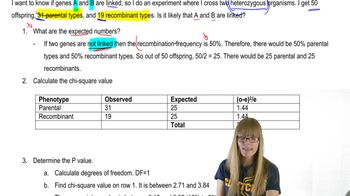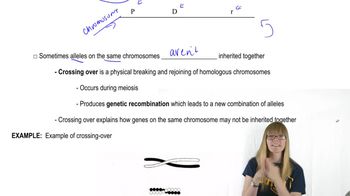Table of contents
- 1. Introduction to Genetics51m
- 2. Mendel's Laws of Inheritance3h 37m
- 3. Extensions to Mendelian Inheritance2h 41m
- 4. Genetic Mapping and Linkage2h 28m
- 5. Genetics of Bacteria and Viruses1h 21m
- 6. Chromosomal Variation1h 48m
- 7. DNA and Chromosome Structure56m
- 8. DNA Replication1h 10m
- 9. Mitosis and Meiosis1h 34m
- 10. Transcription1h 0m
- 11. Translation58m
- 12. Gene Regulation in Prokaryotes1h 19m
- 13. Gene Regulation in Eukaryotes44m
- 14. Genetic Control of Development44m
- 15. Genomes and Genomics1h 50m
- 16. Transposable Elements47m
- 17. Mutation, Repair, and Recombination1h 6m
- 18. Molecular Genetic Tools19m
- 19. Cancer Genetics29m
- 20. Quantitative Genetics1h 26m
- 21. Population Genetics50m
- 22. Evolutionary Genetics29m
4. Genetic Mapping and Linkage
Mapping Overview
Problem 1b
Textbook Question
How do we know that specific genes are linked on a single chromosome, in contrast to being located on separate chromosomes?
 Verified step by step guidance
Verified step by step guidance1
Understand the concept of genetic linkage: genes that are located close together on the same chromosome tend to be inherited together because they are less likely to be separated by recombination during meiosis.
Perform a test cross or a dihybrid cross involving the two genes in question and observe the offspring phenotypes to determine the frequency of recombinant versus parental types.
Calculate the recombination frequency using the formula: \(\text{Recombination Frequency} = \frac{\text{Number of recombinant offspring}}{\text{Total number of offspring}} \times 100\%\).
Interpret the recombination frequency: if the frequency is significantly less than 50%, it suggests the genes are linked on the same chromosome; if it is close to 50%, the genes assort independently and are likely on different chromosomes.
Confirm linkage by repeating the experiment or using molecular techniques such as chromosome mapping or fluorescence in situ hybridization (FISH) to physically locate the genes on chromosomes.
 Verified video answer for a similar problem:
Verified video answer for a similar problem:This video solution was recommended by our tutors as helpful for the problem above
Video duration:
2mPlay a video:
Was this helpful?
Key Concepts
Here are the essential concepts you must grasp in order to answer the question correctly.
Genetic Linkage
Genetic linkage refers to the tendency of genes located close together on the same chromosome to be inherited together during meiosis. Linked genes do not assort independently, which contrasts with genes on different chromosomes that follow Mendel's law of independent assortment.
Recommended video:
Guided course

Chi Square and Linkage
Recombination and Crossing Over
Recombination occurs when homologous chromosomes exchange segments during meiosis, producing new allele combinations. The frequency of recombination between two genes indicates their physical distance on a chromosome; lower recombination rates suggest closer linkage.
Recommended video:
Guided course

Discovery of Crossing Over
Test Cross and Genetic Mapping
A test cross involves breeding an individual heterozygous for certain genes with a homozygous recessive individual to observe offspring phenotypes. Analyzing offspring ratios helps determine if genes are linked and allows construction of genetic maps based on recombination frequencies.
Recommended video:
Guided course

Mapping Overview
Related Videos
Related Practice
Multiple Choice
In the context of bacterial genetic mapping, what does it mean if the trp gene is said to be located at 26 minutes on the E. coli chromosome?
45
views


